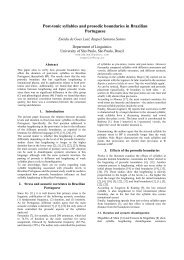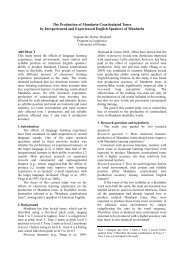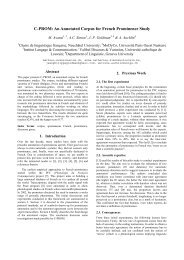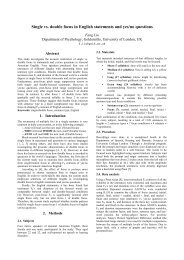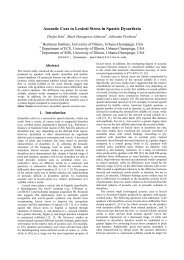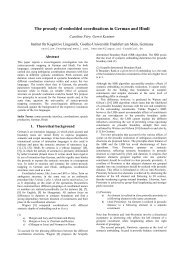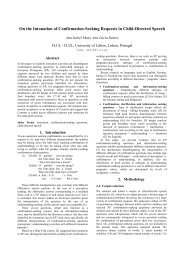Word Accent and Emotion - Speech Prosody 2010
Word Accent and Emotion - Speech Prosody 2010
Word Accent and Emotion - Speech Prosody 2010
Create successful ePaper yourself
Turn your PDF publications into a flip-book with our unique Google optimized e-Paper software.
<strong>Word</strong> <strong>Accent</strong> <strong>and</strong> <strong>Emotion</strong><br />
Dino Seppi 1 , Anton Batliner 2 , Stefan Steidl 2 , Björn Schuller 3 , Elmar Nöth 2<br />
1 ESAT, Katholieke Universiteit Leuven, Belgium<br />
2 Pattern Recognition Lab, University of Erlangen-Nuremberg, Germany<br />
3 Institute for Human-Machine Communication, Technische Universität München, Germany<br />
dino.seppi@esat.kuleuven.be<br />
Abstract<br />
In this paper, we address the question whether prosodically/linguistically<br />
prominent syllables carrying the word accent<br />
(stressed syllables) are better indicators for emotional<br />
marking than unstressed syllables. To this aim, we use a large<br />
spontaneous database with children interacting with Sony’s<br />
Aibo robot, annotated with word-based emotion labels, large<br />
acoustic-prosodic feature vectors, <strong>and</strong> support vector machines<br />
as classifiers. It turns out that, in most of the cases, stressed<br />
syllables are better emotion markers than unstressed syllables.<br />
Moreover, we discuss specific phenomena such as vocatives <strong>and</strong><br />
other constellations, to be modelled in future studies.<br />
Index Terms: emotion, linguistics, paralinguistics, word accent,<br />
lexical stress, automatic classification<br />
1. Introduction<br />
At first sight, the question that we will pursue in this paper<br />
seems to be a strange one: whether emotion 1 conveyed via<br />
speech is a linguistic phenomenon or not – it is common wisdom<br />
that emotion is part of paralinguistics. At second sight, it is<br />
evident that at least those emotions that are signalled with written<br />
language in texts or that can be detected in speech without<br />
any reference to acoustics, are ‘linguistic phenomena’: either<br />
they manifest themselves via language (in object-language) or<br />
at least they are talked about in meta-language. Note that here,<br />
we do not necessarily want or need to incorporate emotions as<br />
part of linguistics the same way as semantics or pragmatics are<br />
parts of linguistics; we rather aim at the means that are used<br />
by humans to signal these phenomena, <strong>and</strong> by that, at the features<br />
<strong>and</strong> units we are using when trying to detect emotions.<br />
Whereas the situation is evident when we deal with written language<br />
– there is no acoustics whatsoever – we can even deal<br />
with speech, trying to detect emotions, without using acoustic<br />
features for this very task itself: we simply can use automatic<br />
speech recognition (ASR) to recognize the spoken word chain,<br />
<strong>and</strong> only syntactic/lexical information (e. g. bag-of-words or n-<br />
grams) for recognizing emotions. Most likely, we will produce<br />
some word errors, but as far as we can see, emotion recognition<br />
does not necessarily deteriorate [1].<br />
The impression that the signalling of emotion in speech is<br />
foremost done with (global) acoustics might be caused by the<br />
long prevailing experimental paradigm: researchers were using<br />
an identical sentence in the lab <strong>and</strong> let their subjects produce<br />
different emotions by changing acoustic parameters (prosody,<br />
tone of voice, etc.). In such a setting, <strong>and</strong> normally even when<br />
1 Note that emotion is used here in a broad sense, encompassing<br />
the ‘proto-typical’, ‘big’ emotions as well as other affective, emotionrelated<br />
states such as stress, boredom, interest, etc.<br />
more realistic speech has been used, longer units such as sentences/turns/utterances/dialogue<br />
moves have been employed in<br />
emotion processing <strong>and</strong> were modelled as such.<br />
The database used in the present study has been annotated<br />
on the word level, <strong>and</strong> several experiments have been conducted<br />
using words [2], turns, or chunks as units [3]. In a<br />
few other studies, alternative types of sub-turn (sub-word) units<br />
have been investigated, for instance voiced segments (sort of<br />
pseudo-syllable) in [4], <strong>and</strong> absolute time intervals, e. g. 500<br />
ms., or relative time intervals (fixed number of segments per<br />
unit with equal length, e. g. three thirds in [5]), cf. as well [6].<br />
Common to such alternative approaches is that they are linguistically<br />
‘blind’ even if automatically detected voiced segments<br />
of course have much in common with syllables.<br />
<strong>Accent</strong>uation is a typical linguistic/prosodic means to signal<br />
different words, or to tell apart different meanings of longer<br />
stretches of words: word accent (lexical stress) is – at least in<br />
languages such as English <strong>and</strong> German – a means to tell apart<br />
words such as ’SUBject vs. sub’JECT, <strong>and</strong> phrase accents signal<br />
different focal structures etc. Leaving aside contrastive accents,<br />
phrase accents are always manifested on word accent position.<br />
Most important might be the role of accentuation in attentional<br />
control <strong>and</strong> in structuring speech.<br />
We will have a look at the signalling of emotion on word<br />
accent (+WA) syllables vs. unaccentuated (-WA) syllables. Our<br />
research interest can be formulated as null vs. alternative hypothesis.<br />
The null hypothesis (H0) claims that the signalling<br />
of emotion is simply modulated onto the speech flow, without<br />
telling apart +/-WA; thus classification performance should be<br />
roughly the same, no matter whether <strong>Word</strong>s, or +WA, or -WA<br />
syllables are used. The alternative hypothesis (H1) claims that<br />
the signalling of emotion has much to do with linguistic structure<br />
<strong>and</strong> by that, it is more pronounced on +WA syllables than<br />
on -WA syllables. In Sec. 5 we discuss whether this alternative<br />
hypothesis can hold or whether there is a simpler explanation.<br />
2. Material <strong>and</strong> annotation<br />
The database used is a German corpus with recordings of children<br />
communicating with Sony’s AIBO pet robot; it is described<br />
in more detail in [3] <strong>and</strong> other papers quoted therein.<br />
The children were led to believe that the AIBO was responding<br />
to their comm<strong>and</strong>s, whereas the robot was actually being<br />
controlled by a human operator who caused the AIBO to perform<br />
a fixed, predetermined sequence of actions; sometimes the<br />
AIBO behaved disobediently, thereby provoking emotional reactions.<br />
The data was collected at two different schools from<br />
51 children (age 10 - 13, 21 male, 30 female; about 8.9 hours of<br />
speech without pauses, sampling rate 16 bits at 16 kHz).<br />
The recordings were segmented automatically into ‘turns’
using a pause threshold of 1000 ms. Five labellers listened to<br />
the turns in sequential order <strong>and</strong> annotated each word as neutral<br />
(default) or as belonging to one of ten other classes. If three<br />
or more labellers agreed, the label was attributed to the word<br />
(majority voting MV). The number of cases with MV is given<br />
in parentheses: joyful (101), surprised (0), emphatic (2528),<br />
helpless (3), touchy i. e. irritated (225), angry (84), motherese<br />
(1260), bored (11), reprim<strong>and</strong>ing (310), rest, i. e. non-neutral<br />
but not belonging to the other categories (3), neutral (39169).<br />
4707 words had no MV; all in all, there were 48401 words. As<br />
some of the labels are very sparse, they are mapped onto main<br />
classes [3]: touchy <strong>and</strong> reprim<strong>and</strong>ing, together with angry, are<br />
mapped onto Angry as representing different but closely related<br />
kinds of negative attitude. (Angry can consist, for instance, of<br />
two touchy <strong>and</strong> one reprim<strong>and</strong>ing label; thus the number of<br />
Angry cases is far higher than the sum of touchy, reprim<strong>and</strong>ing,<br />
<strong>and</strong> angry MV cases.) Some other classes, like joyful, surprised,<br />
helpless, bored, <strong>and</strong> rest do not appear in this subset.<br />
In this study, we restrict to a limited, emotionally rich subset<br />
of the whole database consisting of 4543 chunks (13202<br />
words). Chunks are obtained by manually segmenting utterances<br />
using coarse syntactic <strong>and</strong> prosodic labels (cf. [3] for<br />
more details) <strong>and</strong> by selecting those chunks with at least one<br />
MV word. Subsequently, chunks are automatically segmented<br />
into words <strong>and</strong> syllables by Viterbi alignment [7]; the vocabulary<br />
consists of 525 words (510 syllables).<br />
This selection resulted in a 4-class dataset consisting of<br />
1772 words for Angry, 1238 words for Motherese, 2452 words<br />
for Emphatic, <strong>and</strong> 7740 for Neutral. Note that we did not<br />
downsample frequent classes like Neutral in an attempt of respecting<br />
as much as possible the skewness of the original distribution<br />
of the (remaining) labels. Also note that Emphatic<br />
has to be conceived as a pre-stage of anger because on the valence<br />
dimension, it lies between neutral <strong>and</strong> anger [2, 3]; this is<br />
context-dependent <strong>and</strong> cannot be decided upon in any generic<br />
way, without knowing the data. However, Emphatic is closest<br />
to Neutral <strong>and</strong> thus somehow in-between a clear emotional<br />
state <strong>and</strong> a linguistic-prosodic phenomenon. Finally, syllable<br />
labels are assigned by directly assigning the respective word labels.<br />
Details on syllable <strong>and</strong> word statistics of this subset can<br />
be found in Tab. 1. In Fig. 1, the histogram of words per length<br />
(expressed in number of syllables) <strong>and</strong> per emotion is drawn.<br />
Especially for monosyllabic words, here we – somehow counterfactually<br />
– assume that they are all +WA words; we will come<br />
back to this topic in Sec. 5. Note that 176 words are truncated<br />
<strong>and</strong> the accented syllables are lost.<br />
Table 1: Syllable (-WA, +WA, <strong>and</strong> +/-WA) <strong>and</strong> <strong>Word</strong> statistics<br />
per emotion. 176 truncated words are missing the accented<br />
syllable.<br />
emotion -WA +WA +/-WA <strong>Word</strong><br />
M 370 1226 1596 1238<br />
N 2867 7588 10455 7740<br />
E 924 2450 3374 2452<br />
A 1307 1762 3069 1772<br />
5468 13026 18494 13202<br />
3. Experiments<br />
In this paper, we will address three different classification problems.<br />
First, the 2-class problem Emphatic vs. Neutral (EN); by<br />
that, we can ‘simulate’ the more traditional linguistic/prosodic<br />
word count [#]<br />
9000<br />
8000<br />
7000<br />
6000<br />
5000<br />
4000<br />
3000<br />
2000<br />
1000<br />
0<br />
1 2 3 4 5<br />
word length [# of syllables]<br />
Figure 1: Histogram of words per length [# of syllables], per<br />
emotion.<br />
problem [± PROMINENCE]. This linguistic phenomenon is of<br />
course not the same as the type of emphasis found here, serving<br />
as a sort of ‘pre-stage’ to negative emotion in emotional speech;<br />
however, both phenomena have quite a lot in common although<br />
we are not aware of any study that systematically has investigated<br />
their relationship. Content words, e. g., are more prone to<br />
be linguistically prominent <strong>and</strong> at the same time to be marked<br />
‘emotionally’ than function words.<br />
Second, we address the 3-class problem Angry, Neutral,<br />
<strong>and</strong> Motherese (AMN); by that, we model a typical ‘emotion<br />
constellation’, i. e. valence with a negative, a neutral, <strong>and</strong> a<br />
positive state.<br />
Third, we address the full 4-class problem described above<br />
(AMEN), i. e. we detail negative valence by telling apart the<br />
pre-stage Emphatic <strong>and</strong> the main class Angry; this can be called<br />
a realistic modelling because it is based on all data, i. e. on all<br />
phenomena found to be relevant for emotion processing.<br />
In the following we tackle each one of these classification<br />
problems <strong>and</strong> analyze the result of using different word subunits:<br />
as mentioned already, the speech signal has been segmented<br />
by forced alignment into words <strong>and</strong> syllables. In the<br />
experiments we consider words <strong>and</strong> syllables, which are either<br />
-WA, or +WA, or both -WA <strong>and</strong> +WA (i. e.+/-WA). As we are<br />
interested in the discrimination power of different (sub-) word<br />
units, other important factors should be normalized, such as the<br />
number of items. If it is true that the number of +WA is equal<br />
to the number of <strong>Word</strong>, for our data -WA is far less numerous,<br />
while +/-WA is (almost, cf. Sec. 2) the union of +WA <strong>and</strong><br />
-WA patterns (cf. Tab. 1). To avoid the influence of the heterogeneous<br />
number of items in the classification experiments, we<br />
always r<strong>and</strong>omly down-sampled the number of training patterns<br />
to the multiplicity of the -WA subset. Therefore, the results of<br />
Fig. 2 are obtained by training on (almost) the same amount of<br />
data per class. Another important variable to consider is the<br />
linguistic content: given the quite small (syllable <strong>and</strong> word)<br />
lexicon (cf. Sec. 2), chances are that the classifier is actually<br />
learning the linguistic content in the acoustic patterns. For this<br />
reason, we broke the feature set into two parts: the first group<br />
encompasses prosody-based features alone, while the second<br />
one encloses spectral features only (MFCC). We expect that the<br />
prosodic features are more independent of the linguistic content.<br />
As just anticipated, a purely acoustic feature set is adopted<br />
for this study. We chose the most common <strong>and</strong> at the same time<br />
promising feature types <strong>and</strong> functionals covering prosodic <strong>and</strong><br />
M<br />
N<br />
E<br />
A
79<br />
74<br />
EN<br />
65<br />
60<br />
AMN<br />
55<br />
50<br />
AMEN<br />
MFCC<br />
prosody<br />
all<br />
h [%]<br />
69<br />
55<br />
45<br />
64<br />
50<br />
40<br />
59<br />
-WA +WA +/-WA <strong>Word</strong><br />
45<br />
-WA +WA +/-WA <strong>Word</strong><br />
35<br />
-WA +WA +/-WA <strong>Word</strong><br />
Figure 2: Classification results per configuration (EN, AMN, AMEN) <strong>and</strong> per group of features: 97 prosody-based features (energy<br />
+ pitch + zero-crossing-rate + harmonic-to-noise ratio + duration); 288 MFCC-based; <strong>and</strong> all features together (385). Performance<br />
figures, in %, are harmonic means (h) over the classes of weighted <strong>and</strong> unweighted recalls. Error bars represent st<strong>and</strong>ard errors.<br />
spectral features by exploiting the findings in previous studies<br />
(e. g. [8]). Features are calculated using the openEAR feature<br />
extractor [9]. The whole set comprises 16 low-level descriptors:<br />
energy, pitch, zero-crossing-rate, harmonics-to-noise ratio,<br />
<strong>and</strong> the first 12 Mel-frequency cepstral coefficients. To each<br />
of them, we add the delta coefficients computed to cope with<br />
feature dynamics. Next, 12 functionals are applied on a unit basis:<br />
mean, st<strong>and</strong>ard deviation, kurtosis, skewness, minima <strong>and</strong><br />
maxima with relative positions, range, <strong>and</strong> linear regression coefficients<br />
with the regression error. Duration in frames, as obtained<br />
from the forced alignment, is also added to the feature<br />
set. The total feature vector per word or per syllable, depending<br />
on the analysis, contains up to 385 attributes (288 MFCC-based,<br />
97 prosody-based).<br />
The data are partitioned into three balanced splits (as in<br />
[8]) meeting the following requirements (in order of priority):<br />
speaker-independence, similar distribution of labels, balance<br />
between the two schools, <strong>and</strong> balance between genders. In order<br />
to have a more balanced distribution for training, we upsampled<br />
all classes but Neutral to uniform distributions.<br />
Classification results shown in Fig. 2 are obtained by 3-fold<br />
Cross-Validation (CV). As classifier we opted for Support Vector<br />
Machines (SVM) trained by Sequential Minimal Optimisation<br />
with linear kernel [10]. Parameters are optimized separately<br />
on the three different training sets also by CV.<br />
Figures of classification performance are harmonic means<br />
(h) of weighted (WA) <strong>and</strong> unweighted averaged (UA) recalls:<br />
for very unbalanced datasets like ours this reduces the spread<br />
between UA <strong>and</strong> WA. In this way we give each class the same<br />
importance, <strong>and</strong> we neither penalize sparse classes such as<br />
Motherese nor very frequent ones such as Neutral. In Fig. 2<br />
<strong>and</strong> 3 we scale the y-axis (h) differently as we are not interested<br />
in absolute performance but, mainly, in the relation between<br />
+WA, -WA, <strong>and</strong> <strong>Word</strong> across the three configurations; it could<br />
be expected that fewer classes yield higher performance.<br />
In the following discussion we also consider the accuracy<br />
of the results: st<strong>and</strong>ard errors are estimated by running the<br />
bootstrap algorithm [11], a Monte Carlo method: replications<br />
of h are obtained by r<strong>and</strong>om sampling with replacement from<br />
the training sets. Differences (in h) of at least two st<strong>and</strong>ard<br />
errors greater than zero correspond to p-values of ≃ 5%. Finally,<br />
we draw conclusions on figures that show consistency<br />
across configurations <strong>and</strong> feature sets, <strong>and</strong> should therefore be<br />
less prone to multiplicity effects.<br />
4. Discussion<br />
The results displayed in Fig. 2 confirm our H1 formulated in<br />
Sec. 1. Throughout the three different constellations, independently<br />
of the feature set, -WA syllables perform worse than all<br />
other units; <strong>Word</strong> are the best along with accented syllables<br />
(+WA). The almost identical performance of +WA <strong>and</strong> <strong>Word</strong><br />
could, to some extent, be expected as many words are made of<br />
one syllable only; but, as can be inferred from the histogram of<br />
Fig. 1, there is also a considerable number of words (≃ 30%)<br />
with two or more syllables.<br />
These results, corroborated by the mediocre performance<br />
of the mixture +/-WA, do not mean that there is no information<br />
entailed in -WA syllables that, alone, perform well above<br />
chance level. However, in combination with +WA syllables<br />
when modelling words (<strong>Word</strong>), -WA syllables do not give any<br />
added value: the small improvements (≤ 1.9%±1.2 for MFCC,<br />
AMN) are not significant for any configuration. In other words,<br />
modelling words or only syllables carrying the word accent<br />
(lexical stress) is equivalent. Also note that differences among<br />
acoustic units +WA <strong>and</strong> -WA are larger for EN <strong>and</strong> AMEN, i. e.<br />
those constellations where Emphatic is involved, <strong>and</strong> lower for<br />
AMN but still ample (≥ 7.1% ± 1.4 for MFCC).<br />
The situation is very different if we concentrate on the word<br />
‘Aibo’ only (2257 tokens). From Fig. 3 we notice that the behaviour<br />
of the acoustic units across configurations is quite similar;<br />
more specifically, the +WA syllable does not contribute<br />
more than the -WA syllable. This might be traced back to the<br />
special role of this word <strong>and</strong> its use in the interaction: ‘Aibo’ denotes<br />
the communication partner <strong>and</strong> is practically always used<br />
as vocative, i. e. produced with continuation rise, mostly without<br />
shortening <strong>and</strong>/or centralisation of the -WA syllable; cf. the<br />
notion of ‘calling contour’ [12], or ‘vocative chant’, i. e. H*!H%<br />
in ToBI notation. The duration plots in Fig. 4 clearly show this<br />
difference: for all ‘Aibo’ words there is no clear peak of -WA<br />
syllables [bo:], whereas the frequency peak for the syllables<br />
of all other words is sharper <strong>and</strong> at around 12 frames. Similar<br />
considerations hold for MFCC features alone (Fig. 3): with<br />
identical segmental information, the 2nd syllable can be modelled<br />
very consistently.<br />
In Fig. 2 we display classification results using three differ-<br />
h [%]<br />
66<br />
63<br />
60<br />
57<br />
54<br />
-WA<br />
EN<br />
+WA<br />
60<br />
57<br />
54<br />
51<br />
48<br />
-WA<br />
AMN<br />
+WA<br />
48<br />
45<br />
42<br />
39<br />
36<br />
-WA<br />
AMEN<br />
+WA<br />
Figure 3: Classification results using (-WA or +WA) syllables<br />
from ‘Aibo’ words only. Performance figures in h[%]. Error<br />
bars represent st<strong>and</strong>ard errors. Same legend as Fig. 2.
ent subsets of features, namely prosody-based, MFCC-based,<br />
<strong>and</strong> all the features together. The idea is to isolate the implicit<br />
modelling of the words/syllables induced by MFCC features.<br />
This is probably even more crucial for our data, as they consist<br />
of many mono-syllabic words: the classifier could learn the<br />
syllables that mainly fall in one specific class rather than their<br />
acoustic form. On the other side, as shown in [8], MFCC are<br />
clearly useful in emotion recognition tasks. However, as can<br />
be seen from Fig. 2, acoustic information coded in MFCC does<br />
not add up to prosodic information. One possible explanation is<br />
that, for short units like syllables <strong>and</strong> short words, prosodic phenomena<br />
(like duration or pitch rise/fall) are sharper <strong>and</strong> more<br />
consistent than on longer units like chunks or turns.<br />
normalized counts [%]<br />
normalized counts [%]<br />
14<br />
12<br />
10<br />
8<br />
6<br />
4<br />
2<br />
0<br />
0<br />
14<br />
12<br />
10<br />
8<br />
6<br />
4<br />
2<br />
0<br />
0<br />
10<br />
10<br />
20<br />
20<br />
30<br />
30<br />
syllables from ‘Aibo’ words<br />
40<br />
40<br />
50<br />
50<br />
60<br />
60<br />
syllable duration [frames]<br />
70<br />
syllables from all but ‘Aibo’ words<br />
70<br />
+WA<br />
-WA<br />
80<br />
+WA<br />
-WA<br />
Figure 4: Normalized histograms of syllable durations in frames<br />
(1 frame = 10 ms) for ‘Aibo’ words only <strong>and</strong> for all but ‘Aibo’<br />
words, for both +WA <strong>and</strong> -WA syllable durations.<br />
5. Concluding remarks<br />
There might be a simpler explanation for +WA being better than<br />
-WA: +WA syllables are generally longer, <strong>and</strong> this is probably<br />
the reason why ‘more can happen’ on these syllables, i. e. we<br />
can find more pronounced parameter values for +WA than for<br />
-WA. So we would not have to refer to emotion being – somehow<br />
– part of linguistics. On the other h<strong>and</strong>, there is of course<br />
linguistic reasons for +WA being longer <strong>and</strong> more pronounced;<br />
thus, it is not a typical chicken-<strong>and</strong>-egg problem where we do<br />
not know what came first.<br />
Note that classification performance, full coverage of the<br />
data (open-microphone setting), or feature evaluation have not<br />
been the focus of this study. Moreover, we want to stress that<br />
in this study – the same way as in any other study using realistic<br />
data – only a subset of classes can be modelled which can<br />
be subsumed under ‘appraisal of the interaction within a specific<br />
type of communication: giving comm<strong>and</strong>s to a pet robot’.<br />
80<br />
90<br />
90<br />
This means that the indication of emotion is more conscious <strong>and</strong><br />
thus, most likely, more according to linguistic structure than,<br />
e. g., when speaking in a thoroughly depressed or sad mood.<br />
Yet it has to be shown whether something like sadness really<br />
is modulated onto the speech chain in a fully global way, without<br />
taking into account linguistic structure <strong>and</strong> by that, stress<br />
patterns, at all.<br />
As mentioned above, we counterfactually assign +WA even<br />
to normally unstressed articles or other function words, following<br />
the simplistic rule ‘each mono-syllabic word carries word<br />
accent’. In our context, this means that our results are conservative<br />
because if we modelled unstressed mono-syllabic words<br />
as well, most likely the differences would have been even more<br />
pronounced. This holds for the word level. Apparently, words<br />
carrying the phrase accent are as well more pronounced than<br />
words that do not: this is well known from studies on (semantic)<br />
salience. The same way, such words might be ‘emotionally<br />
prominent’ <strong>and</strong> thus, better c<strong>and</strong>idates for emotion classification<br />
than non-salient words.<br />
6. Acknowledgements<br />
This research has received funding from the European Community under<br />
grant No. RTN-CT-2006-035561 (S2S), No. IST-2001-37599 (PF-<br />
STAR), No. IST-2002-50742 (HUMAINE), <strong>and</strong> No. FP7-2007-211486<br />
(SEMAINE). The responsibility lies with the authors.<br />
7. References<br />
[1] B. Schuller, A. Batliner, S. Steidl, <strong>and</strong> D. Seppi, “<strong>Emotion</strong> Recognition<br />
from <strong>Speech</strong>: Putting ASR in the Loop,” in Proc. of<br />
ICASSP, Taipei, 2009, pp. 4585–4588.<br />
[2] A. Batliner, S. Steidl, C. Hacker, <strong>and</strong> E. Nöth, “Private emotions<br />
vs. social interaction — a data-driven approach towards analysing<br />
emotions in speech,” User Modeling <strong>and</strong> User-Adapted Interaction,<br />
vol. 18, pp. 175–206, 2008.<br />
[3] S. Steidl, Automatic Classification of <strong>Emotion</strong>-Related User<br />
States in Spontaneous Children’s <strong>Speech</strong>. Berlin: Logos Verlag,<br />
2009, PhD thesis.<br />
[4] M. Shami <strong>and</strong> W. Verhelst, “Automatic Classification of Expressiveness<br />
in <strong>Speech</strong>: A Multi-corpus Study,” in Speaker Classification<br />
II, C. Müller, Ed. Berlin: Springer, 2007, pp. 43–56.<br />
[5] B. Schuller, M. Wimmer, L. Mösenlechner, C. Kern, D. Arsic,<br />
<strong>and</strong> G. Rigoll, “Brute-Forcing Hierarchical Functionals for Paralinguistics:<br />
a Waste of Feature Space?” in Proc. of ICASSP, Las<br />
Vegas, 2008, pp. 4501–4504.<br />
[6] T. Vogt <strong>and</strong> E. André, “Comparing feature sets for acted <strong>and</strong><br />
spontaneous speech in view of automatic emotion recognition,”<br />
in Proc. of ICME, Amsterdam, 2005, pp. 474–477.<br />
[7] K. Demuynck, J. Roelens, D. V. Compernolle, <strong>and</strong> P. Wambacq,<br />
“SPRAAK : an open source ‘SPeech Recognition <strong>and</strong> Automatic<br />
Annotation Kit’,” in Proc. of Interspeech, Brisbane, 2008, pp.<br />
495–499.<br />
[8] B. Schuller, A. Batliner, D. Seppi, S. Steidl, T. Vogt, J. Wagner,<br />
L. Devillers, L. Vidrascu, N. Amir, L. Kessous, <strong>and</strong> V. Aharonson,<br />
“The Relevance of Feature Type for the Automatic Classification<br />
of <strong>Emotion</strong>al User States: Low Level Descriptors <strong>and</strong> Functionals,”<br />
in Proc. of Interspeech, Antwerp, 2007, pp. 2253–2256.<br />
[9] F. Eyben, M. Wöllmer, <strong>and</strong> B. Schuller, “openEAR - Introducing<br />
the Munich Open-Source <strong>Emotion</strong> <strong>and</strong> Affect Recognition<br />
Toolkit,” in Proc. of ACII, Amsterdam, 2009, pp. 576–581.<br />
[10] I. H. Witten <strong>and</strong> E. Frank, Data mining: Practical machine learning<br />
tools <strong>and</strong> techniques, 2nd ed. San Francisco: Morgan Kaufmann,<br />
2005.<br />
[11] B. Efron <strong>and</strong> R. J. Tibshirani, An Introduction to the Bootstrap.<br />
New York: Chapman & Hall, 1993.<br />
[12] K. Pike, The intonation of American English. Ann Arbor, Michigan:<br />
University of Michigan Press, 1945.



